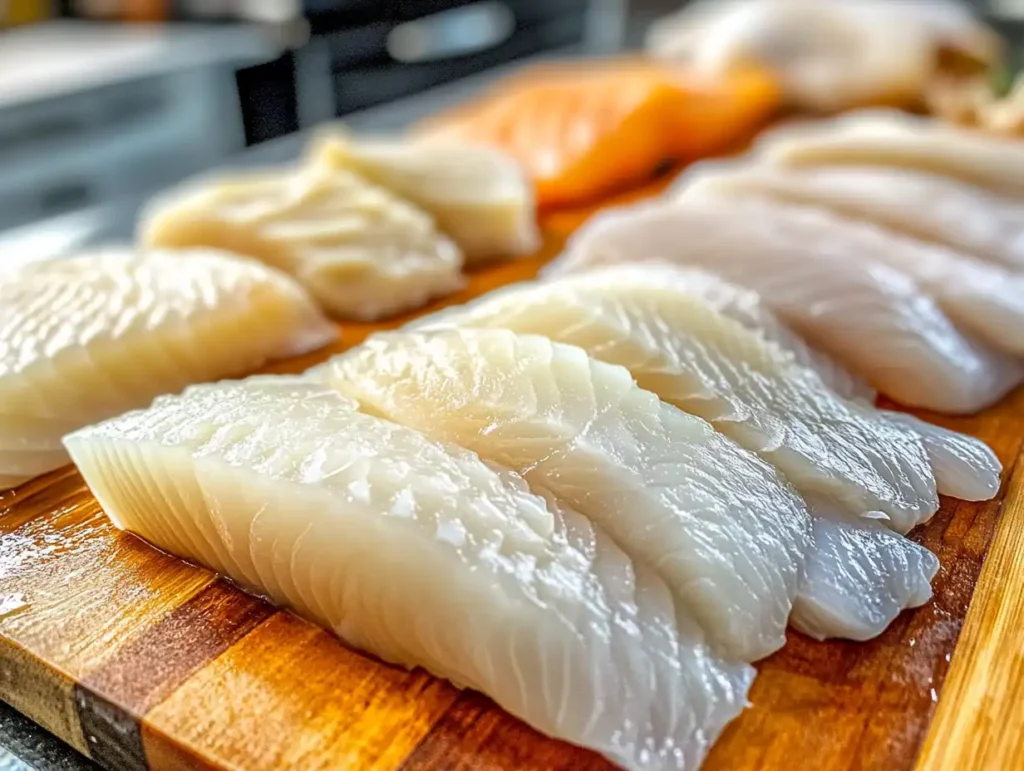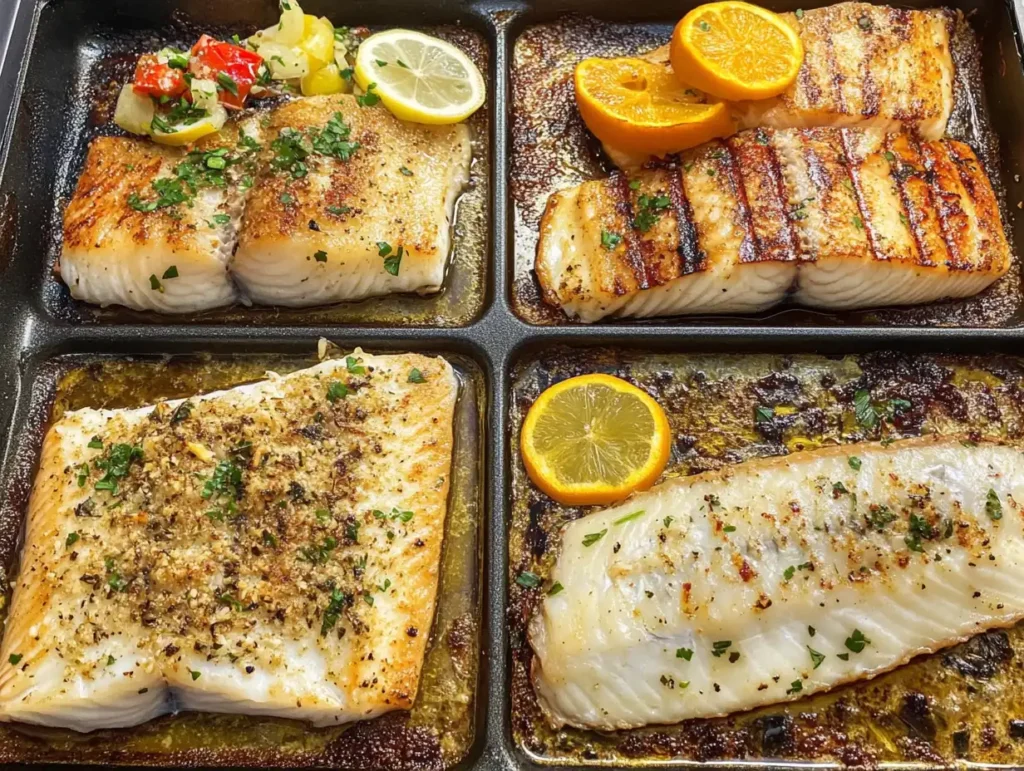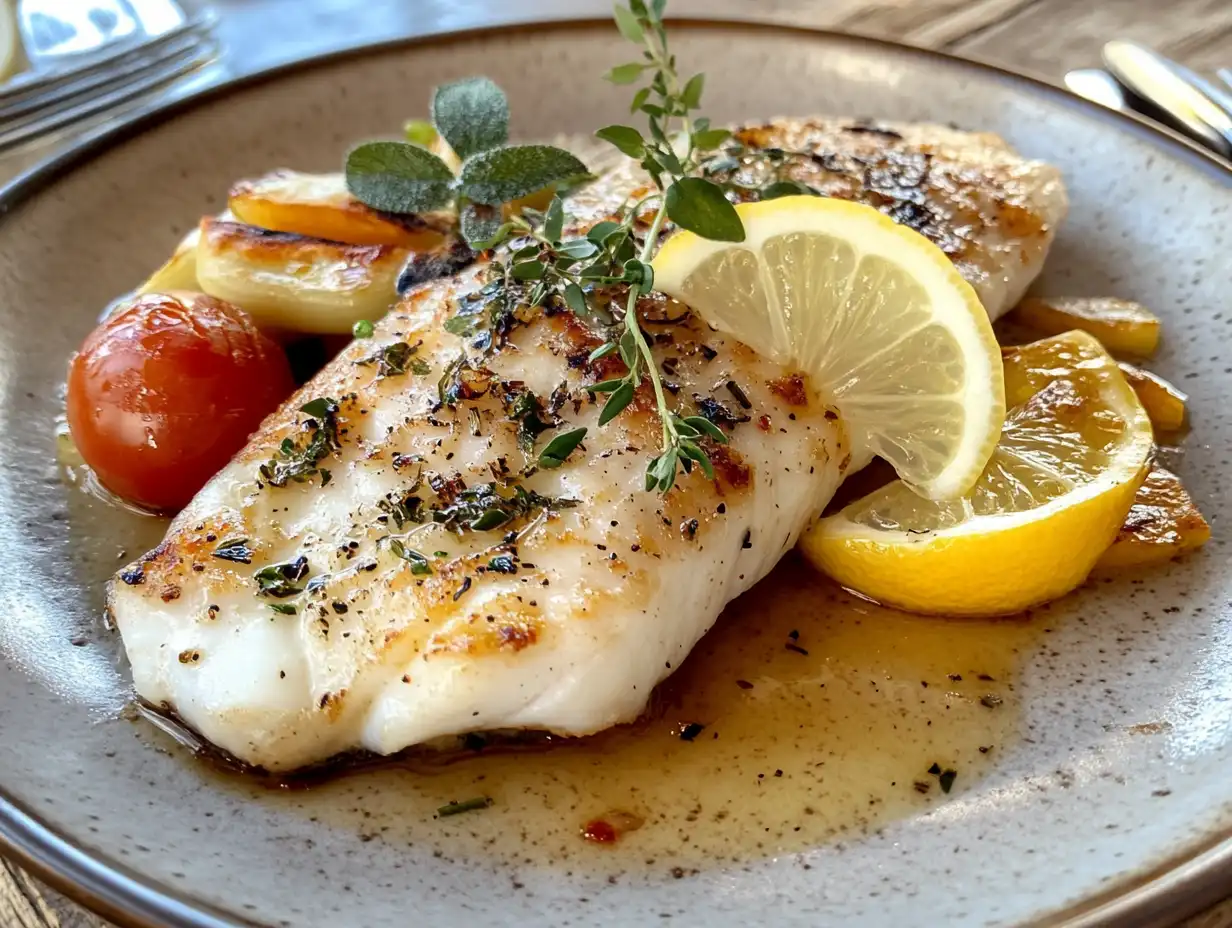Introduction
White fish is a favorite among seafood lovers, home cooks, and professional chefs alike. Its mild flavor, tender texture, and versatility in recipes make it a go-to option for countless dishes. But with so many types of white fish available, it can be hard to determine which one is the best to eat. Factors like taste, nutrition, sustainability, and preparation ease all play a role in the decision.
This guide explores the best white fish to eat, highlighting top choices like cod, haddock, and halibut while providing tips on selecting, preparing, and enjoying them. Whether you’re looking for a nutritious dinner option or experimenting with new recipes, you’ll find plenty of insights to make your choice easier.
What Is White Fish?
White fish refers to a broad category of fish with pale, lean flesh that’s high in protein and low in fat. These fish are often found in freshwater or saltwater and include varieties like cod, haddock, pollock, and tilapia. Unlike oily fish such as salmon or mackerel, white fish have a lighter flavor, making them a versatile option in many cuisines.
Nutritional Benefits of White Fish

When considering what is the best white fish to eat, its health benefits are a top priority. White fish, like cod, haddock, and halibut, are excellent sources of lean protein and essential vitamins, making them strong contenders:
1. High in Protein
White fish provides a lean source of high-quality protein, essential for muscle repair, immune function, and overall body maintenance. A single serving of white fish often contains 20–25 grams of protein.
2. Low in Fat and Calories
If you’re watching your calorie intake or following a low-fat diet, white fish is an ideal choice. Most varieties have less than 100 calories per serving and contain minimal fat.
3. Rich in Omega-3 Fatty Acids
While white fish isn’t as high in omega-3s as oily fish, many types, such as halibut and sea bass, still provide these heart-healthy fats. Omega-3s support brain health, reduce inflammation, and promote cardiovascular health.
4. Packed with Vitamins and Minerals
White fish is a good source of essential nutrients, including:
- Vitamin D: Supports bone health and immune function.
- Vitamin B12: Crucial for energy production and nervous system health.
- Selenium: Acts as an antioxidant, protecting cells from damage.
- Phosphorus: Promotes healthy teeth and bones.
5. Easily Digestible
White fish is gentle on the digestive system, making it a great option for people recovering from illness or with sensitive stomachs.
Top Choices for White Fish
If you’re wondering what is the best white fish to eat, the answer depends on your preferences. Cod and haddock are mild and versatile, while halibut offers a premium option for gourmet meals:
1. Cod
Cod is a versatile and widely loved white fish known for its mild, slightly sweet flavor and flaky texture. It works well in everything from fish and chips to baked dishes. Rich in protein and vitamin B12, cod is a nutritious option for any meal.
2. Haddock
Haddock is similar to cod but with a slightly stronger flavor. Its firm texture makes it perfect for frying, baking, or grilling. It’s a popular choice in traditional dishes like fish pies or smoked haddock chowder.
3. Halibut
A premium choice among white fish, halibut has a firmer texture and a mild, buttery taste. It’s packed with nutrients like magnesium, selenium, and omega-3 fatty acids. Halibut is best when grilled or baked to retain its delicate flavor.
4. Pollock
Pollock is an affordable, sustainable option often used in fish sticks and fast-food fish sandwiches. Its neutral flavor makes it a favorite for frying or incorporating into heavily seasoned dishes. Pollock is a low-calorie, protein-rich choice.
5. Tilapia
Tilapia is one of the most popular white fish due to its affordability and accessibility. With its mild taste and soft texture, tilapia is perfect for pan-frying, baking, or incorporating into curries and stews.
6. Sea Bass
Sea bass is known for its delicate flavor and slightly firm texture. Often used in gourmet recipes, it’s an excellent source of protein and omega-3s. It pairs well with simple seasonings to highlight its natural taste.
How to Select Fresh White Fish
Choosing fresh white fish is crucial for the best flavor and texture. Here are some tips to ensure you’re picking the highest-quality fish:
1. Inspect the Smell
Fresh white fish should have a mild, ocean-like scent. Avoid fish with a strong or unpleasant odor, as this indicates it may no longer be fresh.
2. Examine the Appearance
- Eyes: If you’re buying whole fish, look for clear, bright eyes. Cloudy or sunken eyes suggest the fish is past its prime.
- Skin: The skin should appear shiny and moist, not dull or dry.
- Flesh: For fillets, the flesh should be firm, translucent, and free of discoloration.
3. Check for Firmness
Press gently on the fish with your finger. Fresh fish should bounce back rather than leaving an indentation.
4. Verify the Source
Purchase fish from reputable suppliers or markets that prioritize freshness and quality. Labels indicating wild-caught or sustainably farmed fish are additional indicators of quality.
5. Consider the Packaging
If buying pre-packaged fish, ensure the package is sealed tightly and free of excess liquid. Fish should be stored on ice or in a chilled environment.
Best Cooking Methods for White Fish

White fish is incredibly versatile, lending itself to various cooking methods. Here are the best ways to prepare it:
1. Baking
Baking is a healthy and simple method that preserves the delicate flavor of white fish.
- How to Bake: Preheat your oven to 375°F (190°C), season the fish with herbs, lemon, and olive oil, and bake for 15–20 minutes or until the flesh flakes easily.
- Best Fish for Baking: Cod, halibut, and sea bass.
2. Grilling
Grilling adds a smoky flavor and a slightly crispy texture to white fish.
- How to Grill: Brush the fish with oil to prevent sticking, and cook on medium-high heat for 3–4 minutes per side.
- Best Fish for Grilling: Halibut, sea bass, and haddock.
3. Frying
Frying is a popular choice for creating crispy, golden fish dishes like fish and chips.
- How to Fry: Coat the fish in batter or breadcrumbs and fry in hot oil until golden brown.
- Best Fish for Frying: Cod, haddock, and pollock.
4. Steaming
Steaming is a gentle, low-fat cooking method that retains moisture and nutrients.
- How to Steam: Place the fish in a steamer basket over boiling water, cover, and cook for 8–10 minutes.
- Best Fish for Steaming: Tilapia and sea bass.
5. Poaching
Poaching in broth, wine, or milk keeps the fish tender and infuses it with flavor.
- How to Poach: Submerge the fish in liquid, simmer on low heat for 10 minutes, and serve with a light sauce.
- Best Fish for Poaching: Cod and halibut.
Sustainability Concerns
While white fish is a healthy and delicious choice, it’s essential to consider sustainability to ensure that fish populations and marine ecosystems remain healthy. Overfishing and harmful fishing practices can deplete stocks and damage the environment. Here’s how to make more sustainable choices:
1. Choose Certified Sustainable Fish
Look for certifications like the Marine Stewardship Council (MSC) or Aquaculture Stewardship Council (ASC). These labels indicate that the fish was caught or farmed responsibly.
2. Opt for Wild-Caught or Responsibly Farmed Options
Wild-caught fish often have lower environmental impacts than farmed fish, but this depends on the fishing method. Alternatively, choose responsibly farmed fish from operations that prioritize eco-friendly practices.
3. Avoid Overfished Species
Some popular white fish, such as Atlantic cod, face overfishing pressures. Research fish stocks in your region and choose varieties that are abundant and responsibly managed.
4. Learn About Fishing Methods
Methods like pole-and-line or trap fishing are more sustainable than trawling, which can harm seabed ecosystems and result in bycatch.
5. Support Local Fisheries
Buying fish from local sources reduces the carbon footprint associated with transportation and supports small-scale fishing communities.
Common White Fish Recipes
White fish’s mild flavor and tender texture make it a versatile ingredient in many cuisines. Here are a few easy and delicious recipes to try:
1. Classic Fish and Chips
- Ingredients: Cod or haddock, flour, beer, baking soda, potatoes, and oil.
- Steps: Coat fish in a batter made from flour, beer, and baking soda, then fry until golden brown. Serve with crispy fries and tartar sauce.
2. Baked Cod with Lemon and Garlic
- Ingredients: Cod, lemon, garlic, olive oil, and parsley.
- Steps: Season the cod with lemon juice, garlic, and olive oil. Bake at 375°F (190°C) for 15–20 minutes. Garnish with parsley before serving.
3. Halibut Steaks with Herb Butter
- Ingredients: Halibut steaks, butter, fresh herbs (like dill or parsley), and lemon.
- Steps: Grill halibut steaks and serve with a dollop of herb butter and a squeeze of lemon.
4. Tilapia Tacos
- Ingredients: Tilapia, tortillas, cabbage slaw, lime, and chili seasoning.
- Steps: Season and pan-fry the tilapia, then assemble tacos with slaw and a squeeze of lime.
5. Pollock Fish Cakes
- Ingredients: Pollock, potatoes, breadcrumbs, eggs, and seasoning.
- Steps: Mix cooked pollock with mashed potatoes, form patties, coat in breadcrumbs, and pan-fry until golden.
6. Sea Bass with Tomato and Basil Sauce
- Ingredients: Sea bass, tomatoes, basil, garlic, and olive oil.
- Steps: Sear sea bass in a hot pan, then simmer in a fresh tomato and basil sauce for a Mediterranean-inspired dish.
FAQs About White Fish
White fish often raises a few common questions among seafood enthusiasts and newcomers alike. Let’s address some of these queries to help you better understand and enjoy this delicious seafood option.
1. What is the healthiest white fish to eat?
Cod, haddock, and halibut are among the healthiest white fish choices, thanks to their high protein content, low fat, and rich supply of vitamins like B12 and D. Halibut, in particular, offers a good dose of omega-3 fatty acids.
2. What white fish is best for frying?
Cod and haddock are ideal for frying because of their firm, flaky texture and mild flavor. They hold up well in batters and breadcrumbs, making them a favorite for fish and chips.
3. Is tilapia a good white fish to eat?
Yes, tilapia is a popular choice due to its affordability and neutral taste, which pairs well with various seasonings and dishes. Ensure you select tilapia from responsible sources, as farming practices can vary.
4. How can I tell if white fish is cooked properly?
Cooked white fish will appear opaque and flake easily with a fork. Using a meat thermometer, check for an internal temperature of 145°F (63°C) for perfectly cooked fish.
5. Can white fish be eaten raw?
Certain white fish, like sea bass and halibut, can be eaten raw in dishes like ceviche or sushi. Ensure the fish is sushi-grade, meaning it’s been handled and frozen to kill parasites.
6. What are good substitutes for white fish in recipes?
If you can’t find a specific white fish, you can substitute one mild-flavored variety for another. For example, swap cod with pollock or haddock, or replace sea bass with halibut.
Explore Related White Fish Topics
Expand your knowledge about white fish with these insightful articles:
- For a comprehensive look, check out White Fish: The Ultimate Guide to Its Benefits and Uses to understand its nutritional value and versatile culinary applications.
- Learn about a popular white fish variety in What Kind of Fish Is Branzino? and its unique characteristics.
- Discover tips for preparation and serving in How Do You Cook and Eat Branzino? for an unforgettable dining experience.
These articles will help you master the art of choosing, preparing, and enjoying white fish!
Conclusion
White fish is a treasure trove of culinary possibilities, offering mild flavors, tender textures, and remarkable nutritional benefits. Whether you’re frying up some cod for classic fish and chips, baking a lemony fillet of halibut, or grilling sea bass for a gourmet touch, there’s a white fish to suit every taste and occasion.
Remember to prioritize sustainability when selecting your fish to support healthy oceans and marine life. By making informed choices, you can enjoy the best white fish has to offer while contributing to a sustainable future.
So, what are you waiting for? Dive into the delicious world of white fish and discover your next favorite meal!
